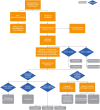Treatment options for biliary tract cancer: unmet needs, new targets and opportunities from both physicians' and patients' perspectives
- PMID: 38861288
- PMCID: PMC11376410
- DOI: 10.1080/14796694.2024.2340959
Treatment options for biliary tract cancer: unmet needs, new targets and opportunities from both physicians' and patients' perspectives
Abstract
Biliary tract cancer (BTC) is a rare cancer with poor prognosis, characterized by considerable pathophysiological and molecular heterogeneity. While this makes it difficult to treat, it also provides targeted therapy opportunities. Current standard-of-care is chemotherapy ± immunotherapy, but several targeted agents have recently been approved. The current investigational landscape in BTC emphasizes the importance of biomarker testing at diagnosis. MDM2/MDMX are important negative regulators of the tumor suppressor p53 and provide an additional target in BTC (∼5-8% of tumors are MDM2-amplified). Brigimadlin (BI 907828) is a highly potent MDM2-p53 antagonist that has shown antitumor activity in preclinical studies and promising results in early clinical trials; enrollment is ongoing in a potential registrational trial for patients with BTC.
Keywords: BI 90782823; MDM2–p53; biliary tract cancer; brigimadlin; plain-language summary; targeted therapy.
Plain language summary
[Box: see text].
Conflict of interest statement
The authors have no competing interests or relevant affiliations with any organization or entity with the subject matter or materials discussed in the manuscript. This includes employment, consultancies, honoraria, stock ownership or options, expert testimony, grants or patents received or pending, or royalties.
Figures




Similar articles
-
MDM2 as a therapeutic target in advanced biliary tract cancers.Oncologist. 2025 May 8;30(5):oyaf094. doi: 10.1093/oncolo/oyaf094. Oncologist. 2025. PMID: 40421959 Free PMC article. Review.
-
Brightline-2: a phase IIa/IIb trial of brigimadlin (BI 907828) in advanced biliary tract cancer, pancreatic ductal adenocarcinoma or other solid tumors.Future Oncol. 2024;20(16):1069-1077. doi: 10.2217/fon-2023-0963. Epub 2024 Jan 12. Future Oncol. 2024. PMID: 38214149 Free PMC article. Clinical Trial.
-
Efficacy and Safety of the MDM2-p53 Antagonist Brigimadlin (BI 907828) in Patients with Advanced Biliary Tract Cancer: A Case Series.Onco Targets Ther. 2024 Mar 29;17:267-280. doi: 10.2147/OTT.S440979. eCollection 2024. Onco Targets Ther. 2024. PMID: 38567193 Free PMC article.
-
Discovery and Characterization of Brigimadlin, a Novel and Highly Potent MDM2-p53 Antagonist Suitable for Intermittent Dose Schedules.Mol Cancer Ther. 2024 Dec 3;23(12):1689-1702. doi: 10.1158/1535-7163.MCT-23-0783. Mol Cancer Ther. 2024. PMID: 39259562 Free PMC article. Clinical Trial.
-
MDM2/X inhibitors under clinical evaluation: perspectives for the management of hematological malignancies and pediatric cancer.J Hematol Oncol. 2017 Jul 3;10(1):133. doi: 10.1186/s13045-017-0500-5. J Hematol Oncol. 2017. PMID: 28673313 Free PMC article. Review.
Cited by
-
MDM2 as a therapeutic target in advanced biliary tract cancers.Oncologist. 2025 May 8;30(5):oyaf094. doi: 10.1093/oncolo/oyaf094. Oncologist. 2025. PMID: 40421959 Free PMC article. Review.
-
Single-cell RNA sequencing analysis of intrahepatic cholangiocarcinoma reveals SPP1 facilitates disease progression via interaction with CD4+ T cells.Oncol Lett. 2025 Jun 10;30(2):390. doi: 10.3892/ol.2025.15135. eCollection 2025 Aug. Oncol Lett. 2025. PMID: 40535101 Free PMC article.
References
Publication types
MeSH terms
Substances
Grants and funding
LinkOut - more resources
Full Text Sources
Other Literature Sources
Research Materials
Miscellaneous
